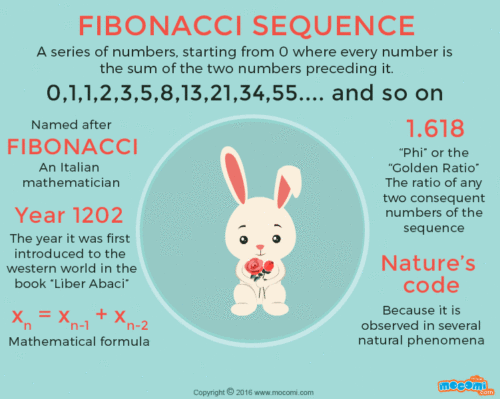Java program to display a Fibonacci Series. We will discuss the various methods to find out the Fibonacci Series In Java Program for the first n numbers. The compiler has been added so that you can execute the set of programs yourself, alongside suitable examples and sample outputs. The methods as aforementioned are:
- Using For Loop.
- Using While Loop.
- Using Static Method.
- Using Recursion.
FIBONACCI SERIES, coined by Leonardo Fibonacci(c.1175 – c.1250) is the collection of numbers in a sequence known as the Fibonacci Series where each number after the first two numbers is the sum of the previous two numbers. The series generally goes like 1, 1, 2, 3, 5, 8, 13, 21 and so on.
Earlier, 0 was also mentioned making the series 0, 1, 1, 2, 3, 5… The sequence can start with either 1, 1 or 0, 1 irrespective. The Fibonacci Sequence follows the very popular Golden Ratio closely.
Fibonacci Series In Java – Using For Loop
1) In Fibonacci series each number is addition of its two previous numbers.
2) Read the n value using Scanner object sc.nextInt(), and store it in the variable n.
3) For loop iterates from c=0 to c=n-1.
a) For c=0 nextterm=0, for c=1 nexterm =1
b) For c=2, nextterm=i+j=1(to get next value we are adding previous two numbers), and “i” initialized to “j” (i.e i=1),”j” initialized to “nextterm” (i.e j=1), for c=3 nextterm =2, for c=4 nextterm=5 .
|
1 2 3 4 5 6 7 8 9 10 11 12 13 14 15 16 17 18 19 20 21 22 23 24 |
import java.util.Scanner; class Fibonacci { public static void main(String[] args) { Scanner sc=new Scanner(System.in); System.out.println("enter number of terms"); int n=sc.nextInt(); int i=0,j=1,nextTerm; System.out.println("Fibonacci series is "); for(int c=0;c<n;c++) { if(c<=1) nextTerm=c; else { nextTerm=i+j; i=j; j=nextTerm; } System.out.println(nextTerm); } } } |
Output:
|
1 2 3 4 5 6 7 8 |
enter number of terms 5 Fibonacci series is 0 1 1 2 3 |
Java Program Display Fibonacci – Using While Loop
1) Read the n value using Scanner object sc.nextInt(), and store it in the variable n.
2) Here first value=0,second value=1, while loop iterates until i<n is false.
3) For i=0 next=0, for i=1 next=1, for 1=2 next=first+second, and first=second,second=next.
|
1 2 3 4 5 6 7 8 9 10 11 12 13 14 15 16 17 18 19 20 21 22 23 24 25 26 |
import java.util.Scanner; class Fibonacci { public static void main(String[] args) { Scanner sc=new Scanner(System.in); System.out.println("enter number of terms"); int n=sc.nextInt(); int first=0,second=1,next; System.out.println("Fibonacci series is "); int i=0; while(i<n) { if(i<=1) next=i; else { next=first+second; first=second; second=next; } System.out.println(next); i++; } } } |
Output:
|
1 2 3 4 5 6 7 8 |
enter number of terms 5 Fibonacci series is 0 1 1 2 3 |
Using Static Method
1) We can call the static method using the class name.
2) Call the series method which is static in the main method.
3) The series method executes the code and prints the series.
|
1 2 3 4 5 6 7 8 9 10 11 12 13 14 15 16 17 18 19 20 21 22 23 24 25 26 27 28 29 |
import java.util.Scanner; class Fibonacci { public static void main(String[] args) { Scanner sc=new Scanner(System.in); System.out.println("enter number of terms"); int n=sc.nextInt(); series(n); } static void series(int num) { System.out.println("Fibonacci series is "); int i=0,j=1,next; for(int c=0;c<num;c++) { if(c<=1) next=c; else { next=i+j; i=j; j=next; } System.out.print(next+" "); } } } |
Output:
|
1 2 3 4 |
enter number of terms 20 Fibonacci series is 0 1 1 2 3 5 8 13 21 34 55 89 144 233 377 610 987 1597 2584 4181 |
Using Recursion
1) In our program fib(int n) method calls itself as fib(–n). Here fib(int n) is the recursive function.
2) After creating an object to the class “Fibonacci”, call the method using object as “f.fib(num)”, then fib(int n) will start the execution with n=5 and calls itself with n=n-1, then again method execution started, repeats until the condition “if(n>0)” is false.
|
1 2 3 4 5 6 7 8 9 10 11 12 13 14 15 16 17 18 19 20 21 22 23 24 25 26 27 28 29 30 31 |
import java.util.Scanner; class Fibonacci { int c=0,i=0,j=1,next; void fib(int n) { if(n>0) { if(c<=1) next=c; else { next=i+j; i=j; j=next; } System.out.print(next+" "); c++; fib(--n); } } public static void main(String[] args) { Scanner sc=new Scanner(System.in); System.out.println("Enter number of terms"); int num=sc.nextInt(); Fibonacci f=new Fibonacci(); System.out.println("Fibonacci series is "); f.fib(num); } } |
Output:
|
1 2 3 4 |
Enter number of terms 5 Fibonacci series is 0 1 1 2 3 |
If you have any doubts related to Java program to display Fibonacci series do leave a comment here.
For More Programs Check out Here:
- List of 500+ Java programs for beginners
- Calculate Area of a circle
- Matrix Multiplication In Java
- Java program for Factorial
 Learn Java Java Tutoring is a resource blog on java focused mostly on beginners to learn Java in the simplest way without much effort you can access unlimited programs, interview questions, examples
Learn Java Java Tutoring is a resource blog on java focused mostly on beginners to learn Java in the simplest way without much effort you can access unlimited programs, interview questions, examples


